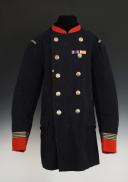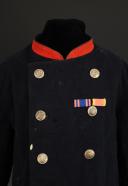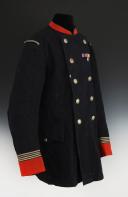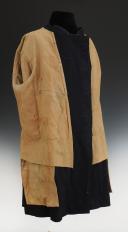
TUNIC OF PAUL COMTE de SAISY de KERAMPUIL, COMMANDER OF THE MOBILE GUARD OF FINISTÈRE, Second Empire, Franco-German War 1870-1871. 27926
Sold out
**PAUL COMTE de SAISY de KERAMPUIL'S TUNIC, COMMANDER OF THE MOBILE GUARD OF FINISTÈRE, Second Empire, Franco-Prussian War 1870-1871. 27926**
Made of dark blue almost black wool, closing in the front with two rows of five buttons each. The buttons are half-bell in silver metal stamped with a Gallic rooster and the inscription "LIBERTY PUBLIC ORDER" (1830/1848 model reused!), with a diameter of 2.4 cm. Scarlet collar. Straight red wool lapels, surmounted by four horizontally sewn silver braids indicating the rank of commander. Side pockets placed at the lower front, with cut-out flaps closing in the middle with a small uniform button. Shoulder loops in silver braid mounted on dark blue wool. Two small uniform buttons are sewn on the back martingale. Dark beige canvas interior lining. The left chest is adorned with ribbons for the Order of Pius IX and for the Castelfitardo Medal.
France.
Second Empire, Franco-Prussian War 1870-1871.
In fairly good condition, moth holes, some damages to the wool including a hole in the middle of the back.
**PROVENANCE:**
Uniform passed down from descendants.
**THE SAISY de KERAMPUIL FAMILY, A FAMILY CONNECTED TO THE PONTIFICAL ZOUAVES:**
**PAUL Césaire Emmanuel Marie Constantin, Count de SAISY de KERAMPUIL**, born in Kersaint-Éloy (Côtes du Nord) on February 29, 1830. He started as a soldier and rose through the ranks from sergeant to lieutenant colonel! He was one of the four battalion commanders of the pontifical zouaves in Rome from 1868 to 1870.
Engaged with the Franco-Belgian Pontifical skirmishers in Rome on June 29, 1860, he served as a sergeant at Castelfidaro on September 18, 1860, and was appointed second lieutenant on October 1, 1860. Assigned to the Pontifical Zouaves on January 1, 1861, he was promoted to lieutenant on March 19, 1861, then to captain on June 18, 1861, and to battalion commander on December 27, 1868.
During the war, he was appointed commander in the mobile guard of the Finistère in 1870. Promoted to the rank of lieutenant colonel in 1871 and knight of the Legion of Honor in August 1871. He later became the colonel of the mobiles of Guingamp, then chief of the 4th brigade of the Cathelineau division in the Brittany army, and, after the war, he led, with the rank of lieutenant colonel, the 73rd territorial infantry regiment.
A councilor and deputy of Finistère (1885-1889), and president of the agricultural committee of Carhaix, he was elected on the conservative list of Finistère in the elections of October 4, 1885; he aligned with the Union of the Right, opposing the school and colonial policies of the republican ministries, and voting against the reintroduction of the district voting system, for the indefinite postponement of the Constitution revision, against the prosecution of three deputies who were members of the League of Patriots, against the Lisbon bill limiting press freedom, and against the prosecution of General Boulanger.
Paul de Saisy did not seek reelection in 1889 and then focused on the mayorship of Plouguer. He passed away on April 26, 1894, in Rennes at the age of 65, and was interred on May 1, 1894, at the Carhaix-Plouguer Cemetery, Finistère. The burial place of the Saisy de Kerampuil family is located in front of the church.
**Military Campaigns:** Marittima and Campagna Mobile Column in 1860. Ponte Corese affair, 1861. Campaign of 1867. Siege of Rome, 1870. Retreat from Viterbo and the siege of Rome. Campaign of France, as lieutenant colonel of the Mobiles of Finistère.
**Orders and Decorations:** Knight of the Order of Pius IX, Castelfitardo Medal, Mentana and Bene Merenti Medal, Knight of the Legion of Honor.
The text continues with details about other members of the Saisy de Kerampuil family and the history of the Zouaves Pontificaux battalion, its formation, campaigns, and disbandment.
Made of dark blue almost black wool, closing in the front with two rows of five buttons each. The buttons are half-bell in silver metal stamped with a Gallic rooster and the inscription "LIBERTY PUBLIC ORDER" (1830/1848 model reused!), with a diameter of 2.4 cm. Scarlet collar. Straight red wool lapels, surmounted by four horizontally sewn silver braids indicating the rank of commander. Side pockets placed at the lower front, with cut-out flaps closing in the middle with a small uniform button. Shoulder loops in silver braid mounted on dark blue wool. Two small uniform buttons are sewn on the back martingale. Dark beige canvas interior lining. The left chest is adorned with ribbons for the Order of Pius IX and for the Castelfitardo Medal.
France.
Second Empire, Franco-Prussian War 1870-1871.
In fairly good condition, moth holes, some damages to the wool including a hole in the middle of the back.
**PROVENANCE:**
Uniform passed down from descendants.
**THE SAISY de KERAMPUIL FAMILY, A FAMILY CONNECTED TO THE PONTIFICAL ZOUAVES:**
**PAUL Césaire Emmanuel Marie Constantin, Count de SAISY de KERAMPUIL**, born in Kersaint-Éloy (Côtes du Nord) on February 29, 1830. He started as a soldier and rose through the ranks from sergeant to lieutenant colonel! He was one of the four battalion commanders of the pontifical zouaves in Rome from 1868 to 1870.
Engaged with the Franco-Belgian Pontifical skirmishers in Rome on June 29, 1860, he served as a sergeant at Castelfidaro on September 18, 1860, and was appointed second lieutenant on October 1, 1860. Assigned to the Pontifical Zouaves on January 1, 1861, he was promoted to lieutenant on March 19, 1861, then to captain on June 18, 1861, and to battalion commander on December 27, 1868.
During the war, he was appointed commander in the mobile guard of the Finistère in 1870. Promoted to the rank of lieutenant colonel in 1871 and knight of the Legion of Honor in August 1871. He later became the colonel of the mobiles of Guingamp, then chief of the 4th brigade of the Cathelineau division in the Brittany army, and, after the war, he led, with the rank of lieutenant colonel, the 73rd territorial infantry regiment.
A councilor and deputy of Finistère (1885-1889), and president of the agricultural committee of Carhaix, he was elected on the conservative list of Finistère in the elections of October 4, 1885; he aligned with the Union of the Right, opposing the school and colonial policies of the republican ministries, and voting against the reintroduction of the district voting system, for the indefinite postponement of the Constitution revision, against the prosecution of three deputies who were members of the League of Patriots, against the Lisbon bill limiting press freedom, and against the prosecution of General Boulanger.
Paul de Saisy did not seek reelection in 1889 and then focused on the mayorship of Plouguer. He passed away on April 26, 1894, in Rennes at the age of 65, and was interred on May 1, 1894, at the Carhaix-Plouguer Cemetery, Finistère. The burial place of the Saisy de Kerampuil family is located in front of the church.
**Military Campaigns:** Marittima and Campagna Mobile Column in 1860. Ponte Corese affair, 1861. Campaign of 1867. Siege of Rome, 1870. Retreat from Viterbo and the siege of Rome. Campaign of France, as lieutenant colonel of the Mobiles of Finistère.
**Orders and Decorations:** Knight of the Order of Pius IX, Castelfitardo Medal, Mentana and Bene Merenti Medal, Knight of the Legion of Honor.
The text continues with details about other members of the Saisy de Kerampuil family and the history of the Zouaves Pontificaux battalion, its formation, campaigns, and disbandment.
Reference :
27926
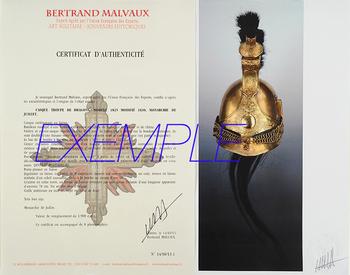
Next update Friday, april 4th at 1:30 PM
FOR ALL PURCHASES, PAYMENT IN MULTIPLE CHECKS POSSIBLE
bertrand.malvaux@wanadoo.fr 06 07 75 74 63
An authenticity certificate of the item including the description published on the site, the period, the sale price, accompanied by one or more color photographs is automatically provided for any item priced over 130 euros. Below this price, each certificate is charged 5 euros.
Only items sold by me are subject to an authenticity certificate, I do not provide any expert reports for items sold by third parties (colleagues or collectors).
